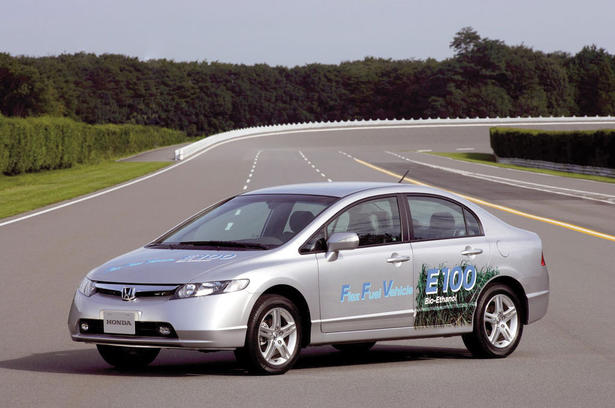
Honda will present the Honda Civic FFV (Flexible Fuel Vehicle) at this year's Tokyo Motor Show. The Honda Civic FFV is already present in Brazil alongside the Fit FFV. Brazil was chosen because it has well established bio-ethanol fuelling infrastructure.
The Honda Civic FFV has a 1.8 liter engine that develops 103kW(140PS) at 6,200rpm on ethanol and 102kW(138PS) and 6,200rpm on gasoline. The torque figures are 174Nm(17.7kg/m) at 4,300rpm for ethanol and 172Nm(17.5kg/m) at 5,000rpm for gasoline.
Honda Press Release:
Honda Flexible Fuel Vehicle (FFV)
Honda’s heritage is steeped in research, technological developments, and a long-standing commitment to providing environmentally-sustainable transport. That’s why we’ve tried and tested all manner of options – solar powered vehicles, electric motors, fuel cell and hybrid technology. So it comes as no surprise that Honda is working on the development of biofuel cars, too.
Honda firmly believes that the most effective way to significantly reduce CO2 emissions in the current UK marketplace is through petrol-electric hybrid technology. This is because
the infrastructure and product is already currently available. For the future, our long-term solution is the fuel cell vehicle – FCX – which runs on compressed hydrogen and emits nothing but water.
So you may wonder why Honda is developing an FFV? Well, in countries like Brazil, the biofuel marketplace is well-established and a comprehensive fuelling infrastructure already exists. Knowing of the potential environmental gains to be reaped from developing biofuels, in September 2006, Honda announced that it had created a new flexible fuel vehicle (FFV) system
that enables petrol engines to operate on either 100 per cent ethanol or a wide range of ethanol-petrol fuel mixtures.
There are two versions of FFV currently on sale in Brazil – a Civic FFV and Fit FFV. Both can run on up to 85 per cent bioethanol.
Up to now, variations in the ratio of ethanol-to-petrol have affected low-temperature start-up
performance, and caused variations in air-to-fuel ratio and engine output. This has made it a challenge to maintain stable performance, fuel economy and emissions levels.
Based on measurements of exhaust gas concentrations, the Honda FFV system adapts to different ethanol-to-petrol ratios in the ethanol-petrol blend. This gives the FFV the flexibility to run on ethanol-to-petrol ratios between 20 per cent and 100 per cent, while still achieving outstanding fuel economy and dynamic performance on a par with a 100 per cent petrol-powered vehicle. To ensure reliable starts even from cold, a secondary fuel tank has been added.












